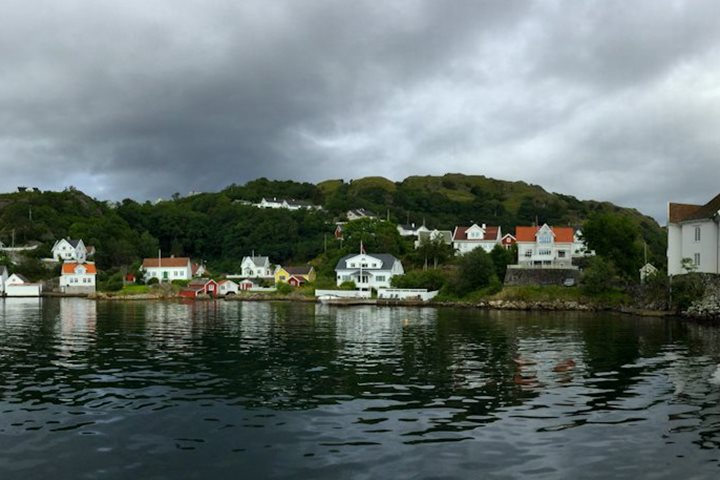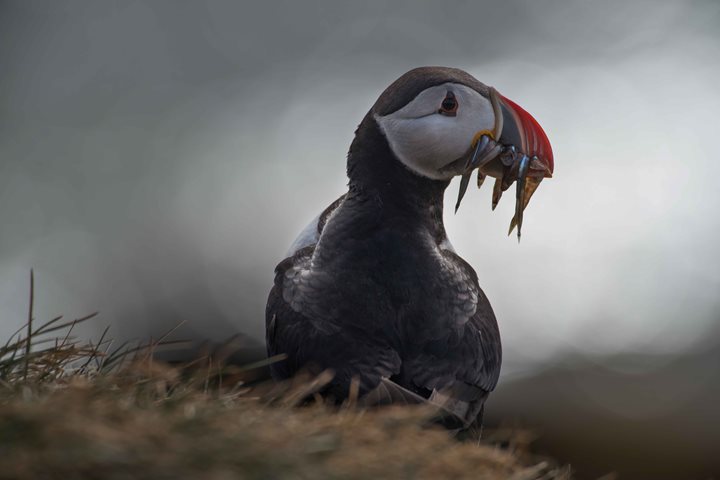National Geographic Explorer reached the spectacular Latrabjarg Cliff of Iceland’s rugged northwestern region during breakfast. This is Europe's largest bird cliff…it measures about 14km (9mi) in length and rises to 440m (1,450ft) in height. These impressive volcanic cliffs are composed of ancient Tertiary basaltic outflows. It has been formed by many separate layers of lava flows that can easily be seen from afar (Figure A). The interfaces of the adjacent layers have produced long, horizontal ledges that provide perfect housing to millions of nesting seabirds. Nearly 40% of the world’s population of razorbills nest here, as well as countless thousands of guillemots (or common murres), Atlantic puffins, black guillemots, fulmars, and kittiwakes. Most of the cliff nesters had already fledged their chicks by this time, and the nesting ledges were virtually empty today. However, many puffins, razorbills, and guillemots were observed swimming just offshore. In addition, there were plenty of northern fulmars, kittiwakes, and herring gulls in evidence. A few ravens were sighted high above the cliff face and several arctic skuas were seen chasing kittiwakes. For centuries, brave men were roped down on the Latrabjarg cliff face during the short bird breeding season to collect tens of thousands of nesting birds and their eggs for use as food and a source of oil.
We arrived off Flatey, which translates to Flat Island, in the early afternoon and started going ashore right after lunch. Flatey is the largest of more than a thousand islands and islets located in Breidafiord (Broad Bay). It was settled by a Viking chieftain in the early 10th century, making it one of the earliest Viking settlement sites in Iceland. Flat islands such as this, with rich, deep soils, were desired by Nordic people for ease of farming and grazing sheep. In addition, the open seas surrounding the island were rich in marine resources, and of course, one could better watch for approaching enemies and invaders. These attributes helped make Flatey an important trading post during the Middle Ages. A monastery was founded here in 1172 by Augustinians, which made Flatey the center of culture and education in Iceland at this time. The Flateyjarbok, a collection of 113 pages of illuminated medieval manuscripts on vellum (stretched calf skin) pages, was produced in 1387 at Vididalstunga in northern Iceland and somehow turned up here in the possession of one of Flatey’s farms in the 15th century. In 1659, after the Reformation and Iceland coming under the control of Denmark, the Flateyjarbok was taken from Flatey to Copenhagen. The Danish government gave the book back to Iceland in 1971, under great fanfare in Reykjavik, and it is now conserved in the Cultural Palace in Reykjavik.
The monastery was eventually moved to Helgafell, on the Snaefellsnes peninsula, but there is now a modern Lutheran church standing just in front of the old monastic site. This attractive little church was built in 1926 and has an extensive display of colorful murals on the ceiling and altar wall. The artwork was produced by a Catalan (Spanish) artist, Baltasar Samper, in the late 1960s and early 1970s. He was given free accommodation in the village in exchange for his artistry. The amazing art includes an image of Jesus Christ behind the altar wearing an Icelandic woolen sweater, along with extensive ceiling murals depicting the history of the Flateyjarbok to one side and scenes from island life on the other (Figure B). The characters in the murals were all modeled by local people. Behind the church is a tiny restored yellow wooden building built in 1864 that houses the oldest and smallest library in continuous use in Iceland. It is also the first public library in Iceland. Inside the building are photocopied images of the Flateyjarbok.
Flatey is now a nature sanctuary, but still has two working farms with just seven people living on the island all year round. Flatey remained an important cultural center well into the 1800s, but the island’s population collapsed in the first half of the 20th century when many people left the island in search of better paying jobs. The remaining houses have now been renovated and the village looks rather like an idyllic movie set. These homes are used generally only during the short summer season, which coincidentally is the same time that many breeding birds can be found here. We were able to observe many of the nesting species that utilize this island, including northern fulmars, snipe, red-necked phalaropes, ringed plovers, redshanks, purple sandpipers, oystercatchers, eiders, mallard ducks, a single graylag goose, black guillemots, Atlantic puffins, glaucous gulls, Icelandic gulls, kittiwakes, arctic terns, snow buntings, white wagtails, and probably a few other species.









